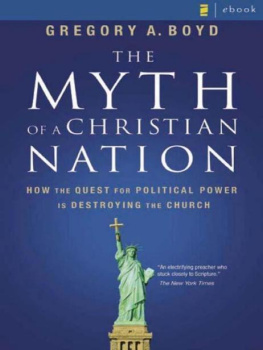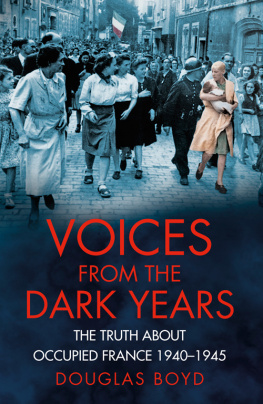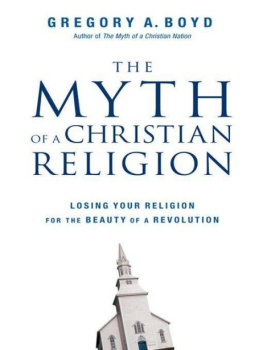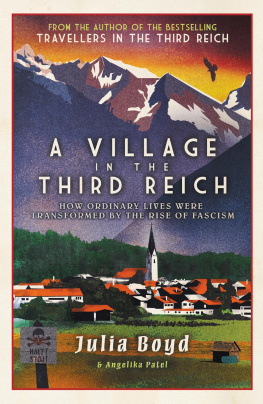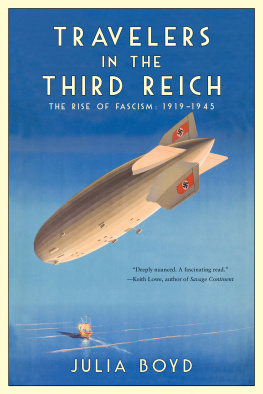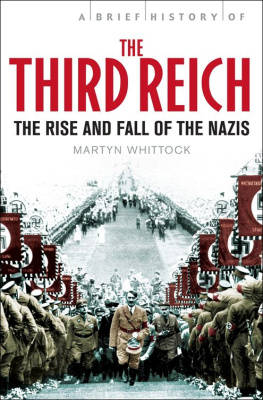

For
Mackenzie, Harrison, Bella,
Robbie, Edie, Sebastian,
Matthew, Zoe, Jemima
and Clio
Contents
Introduction
I magine that it is the summer of 1936 and you are on honeymoon in Germany. The sun is shining, the people are friendly life is good. You have driven south through the Rhineland, admiring its castles and vineyards, and have watched fascinated as the huge, heavily laden barges ply their way slowly up the Rhine. Now you are in Frankfurt. You have just parked your car, its GB sticker prominently displayed, and are about to explore the city, one of the medieval architectural gems of Europe.
Then, out of nowhere, a Jewish-looking woman appears and approaches you. Radiating anxiety, she clutches the hand of a limping teenage girl wearing a thick built-up shoe. All the disturbing rumours you have heard about the Nazis the persecution of Jews, euthanasia, torture and imprisonment without trial are at that moment focused on the face of this desperate mother. She has seen your GB sticker and begs you to take her daughter to England. What do you do? Do you turn your back on her in horror and walk away? Do you sympathise but tell her there is really nothing you can do? Or do you take the child away to safety?
I first heard this true story from the daughter of the English couple, as we sat in her tranquil Cambridge garden sipping lemonade one hot summer afternoon. When Alice showed me the photograph of a smiling Greta holding her as a baby, confirming the remarkable and happy outcome of this particular travellers tale, I tried to place myself in her parents shoes. How would I have reacted had I found myself in the same situation? It took only seconds to conclude that, however touched by the womans plight and no matter how appalled by the Nazis, I would almost certainly have opted for the middle course. But although it is easy enough to imagine our response in such circumstances, do we really know how we would react? How we would interpret what is going on right in front of our eyes?

This book describes what happened in Germany between the wars. Based on first-hand accounts written by foreigners, it creates a sense of what it was actually like, both physically and emotionally, to travel in Hitlers Germany. Scores of previously unpublished diaries and letters have been tracked down to present a vivid new picture of Nazi Germany that it is hoped will enhance even challenge the readers current perceptions. For anyone born after the Second World War, it has always been impossible to view this period with detachment. Images of Nazi atrocities are so powerful that they can never be suppressed or set aside. But what was it like to travel in the Third Reich without the benefit of post-war hindsight? How easy was it then to know what was really going on, to grasp the essence of National Socialism, to remain untouched by the propaganda or predict the Holocaust? And was the experience transformative or did it merely reinforce established prejudices?
These questions, and many others, are explored through the personal testimony of a whole range of visitors. Celebrities like Charles Lindbergh, David Lloyd George, the Maharaja of Patiala, Francis Bacon, the King of Bulgaria and Samuel Beckett passed through, to name just a few. But also ordinary travellers, from pacifist Quakers to Jewish Boy Scouts; African-American academics to First World War veterans. Students, politicians, musicians, diplomats, schoolchildren, communists, poets, journalists, fascists, artists and, of course, tourists many of whom returned year after year to holiday in Nazi Germany all have their say, as well as Chinese scholars, Olympic athletes and a pro-Nazi Norwegian Nobel laureate. The impressions and reflections of these assorted travellers naturally differ widely and are often profoundly contradictory. But drawn together they generate an extraordinary three-dimensional picture of Germany under Hitler.
Many people visited the Third Reich for professional reasons, others simply to enjoy a good holiday. Yet more were motivated by a long love affair with German culture, family roots or often just sheer curiosity. Against a background of failing democracy elsewhere and widespread unemployment, right-wing sympathisers went in the hope that lessons learned from a successful dictatorship might be replicated back home while those subscribing to a Carlylean worship of heroes were eager to see a real bermensch [superman] in action. But no matter how diverse the travellers politics or background, one theme unites nearly all a delight in the natural beauty of Germany. You did not have to be pro-Nazi to marvel at the green countryside, the vineyard-flanked rivers or the orchards stretching as far as the eye could see. Meanwhile, pristine medieval towns, neat villages, clean hotels, the friendliness of the people and the wholesome cheap food, not to mention Wagner, window-boxes and foaming steins of beer, drew holiday-makers back year after year even as the more horrific aspects of the regime came under increasing scrutiny in their own countries. It is, of course, the human tragedy of these years that remains paramount, but the extraordinary pre-war charm of such cities as Hamburg, Dresden, Frankfurt or Munich, highlighted in so many diaries and letters, serves to emphasise just how much Germany and indeed the whole world lost materially because of Hitler.
Travellers from America and Britain vastly outnumbered those from any other country. Despite the Great War, a large section of There was much truth in this.
By 1937 the number of American visitors to the Reich approached half a million per annum.the profusion of uniforms and flags, the constant marching and heiling but wasnt that just the Germans being German? Travellers frequently remarked with distaste on the abundance of anti-Semitic notices. But, however unpleasant the treatment of Jews, many foreigners considered this to be an internal matter and not really their business. Moreover, as they were so often themselves anti-Semitic, many accepted that the Jews did indeed have a case to answer. As for newspaper attacks on the Reich, these were often discounted since everyone knew journalists penchant for sensationalising the least little incident. People also remembered how German atrocities reported in the newspapers during the early weeks of the First World War were later proven to have been false. As Louis MacNeice put it,
But that, we thought to ourselves, was not our business
All that the tripper wants is the status quo
Cut and dried for trippers.
And we thought the papers a lark
With their party politics and blank invective
While much of the above may have been true for the average tourist, what of those who travelled in the Third Reich for professional reasons, or who went specifically to explore and understand the new Germany? In the early months of Nazi rule, many foreigners found it difficult to know what to believe. Was Hitler a monster or a marvel? Although some visitors remained agnostic, the evidence suggests that, as the years went by, the majority had made up their minds even before they set foot in the country. They went to Germany (as indeed they did to Soviet Russia) intent on confirming rather than confronting their expectations. Surprisingly few, it would seem, underwent a change of heart as a direct result of their travels. Those on the right therefore found a hard-working, confident people, shaking off the wrongs they had suffered under Versailles while at the same time protecting the rest of Europe from Bolshevism. To them, Hitler was not only an inspirational leader but also as one enthusiast after another was so keen to state a modest man, utterly sincere and devoted to peace. Those on the left, meanwhile, reported a cruel, oppressive regime fuelled by obscene racist policies using torture and persecution to terrorise its citizens. But on one aspect, both could agree. Adored by millions, Hitler had the country totally in his grip.
Next page



